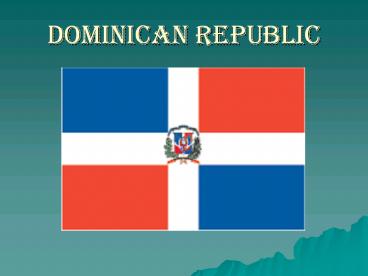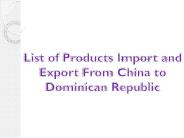Dominican Republic - PowerPoint PPT Presentation
1 / 11
Title:
Dominican Republic
Description:
The Dominican Republic is a representative democracy with government authority ... The presidency system in the Dominican Republic is very much the same as The ... – PowerPoint PPT presentation
Number of Views:3079
Avg rating:3.0/5.0
Title: Dominican Republic
1
Dominican Republic
2
(No Transcript)
3
History
- In the 15th century the island was first occupied
by the Taino people. These people created five
kingdoms to which they hunted small game, went
fishing, and cultivated different crops such as,
cassava, corn, squash, beans, sweet potatoes,
peppers, peanuts, and yams. - Colonizers later came to the island in 1495 and
abused the Taino people. It is estimated that
the population reduced from 60,000 in 1507 to 600
in 1531. - Santo Domingo's importance for the Spanish Crown
diminished in the early 16th century due to the
discovery of gold and silver in Mexico and Peru,
and the Caribbean colony's population dwindled.
The economy remained basically stagnant for the
next 250 years, approximately.
4
History
- In the mid-1600s, French buccaneers settled in
the western end of the island, and soon France
moved to colonize the area. Spain ceded the
territory to France in 1697, after three decades
of intermittent warfare. The French colony of
Saint-Domingue soon became the most productive
agricultural economy in the Western Hemisphere. - Trade restrictions were gradually restricted in
the 18th century leading to an increase in the
population from approximately 6,000 in 1737 to
around 125,000 in 1790. - In 1804, after a long, brutal revolution led by
the former black slave Toussaint L'Ouverture and
later by Jean-Jacques Dessalines, the colony of
Saint-Domingue became the Republic of Haiti. - In 1844, forces led by Juan Pablo Duarte, the
hero of Dominican independence, drove the
Haitians out and established the Dominican
Republic as an independent state.
5
Government Functions
- The Dominican Republic is a representative
democracy with government authority divided among
independent executive, legislative and judicial
branches. - The presidency system in the Dominican Republic
is very much the same as The United States. A
president is elected and given only a few duties
and they can only hold office for four years at a
time. The only differences are that the
president of the Dominican Republic can not be
re-elected and in an election they must win by 50
percent plus one vote. - The Dominican Republic has a multi-party
political system with national elections every
four years. Voter turnout is generally very high,
as exemplified by the fact that in the two rounds
of presidential elections in 1996, nearly 80
percent of eligible Dominicans went to the polls.
6
Foreign Relations
- The Dominican Republic belongs to the United
Nations and many of its specialized and related
agencies, including the World Bank, the
International Labor Organization, the
International Atomic Energy Agency, and the
International Civil Aviation Organization. - The Dominican Republic has a close relationship
with the United States and with the other states
of the Inter-American system. It has accredited
diplomatic missions in most Western Hemisphere
countries and in principal European capitals. The
Dominican Republic and Cuba recently established
consular relations, and there is contact in
fields such as commerce, culture and sports.
Dominican relations with its closest neighbor,
the Republic of Haiti, have never been extensive.
The expulsion of 20,000 illegal Haitian
immigrants in early 1997 resulted in tension
between the two countries. The tension was
relieved with an agreement that international
observers would monitor the process.
7
Environmental Overview
- Key current environmental issues in the Dominican
Republic include the following - Water Shortages
- soil erosion, as a result of slash and burn
agricultural practices - deforestation, as a result of timber exploitation
for energy resources (fuel) - damage to coral reefs and mangroves, as a result
of human activities
8
People
- About half of Dominicans live in rural areas, and
many of them are small landholders. However,
rural citizens have migrated in large numbers to
major cities such as Santo Domingo and Santiago
de los Caballeros in the past decades urban
areas continue to grow rapidly. - Most of the population of the Dominican Republic
is of mixed African and European ancestry. There
are significant distinct populations of people of
African and European extraction, as well.
Haitians form the largest foreign minority
group. - The state religion of the Dominican Republic is
Roman Catholicism, but there is no religious
restriction. - The official language is Spanish.
9
Quality of Life
- The Dominican Republic's infant mortality rate is
34.19 deaths per 1,000 births, according to
a recent estimate. The life expectancy at birth
for the total population was estimated in the
last year to be 67.96 years - 66.41 years for
males and 69.58 years for females. The literacy
rate of citizens over the age of 15 was estimated
in the last year to be 84.7 percent,
disaggregated to 84.6 percent of males and 84.8
percent of females.
10
Tips when traveling..
- When traveling to the Dominican Republic there
are a few facts to know to avoid getting sick - Don't eat food purchased from street vendors.
Don't drink beverages with ice. Don't
handle animals (especially monkeys, dogs, and
cats), to avoid bites and serious diseases
(including rabies and plague). - Don't swim in fresh water. Salt water is
usually safer.
11
To Stay Healthy, Do
- Drink only bottled or boiled water, or
carbonated (bubbly) drinks in cans or bottles.
Avoid tap water, fountain drinks, and ice cubes.
If this is not possible, make water safer by BOTH
filtering through an "absolute 1-micron or less"
filter AND adding iodine tablets to the filtered
water. "Absolute 1-micron filters" are found in
camping/outdoor supply stores. - If you visit an area where there is risk for
malaria, take your malaria prevention medication
before, during, and after travel, as directed.
(See your doctor for a prescription.) - Protect yourself from insects by remaining in
well-screened areas, using repellents (applied
sparingly at 4-hour intervals) and
permethrin-impregnated mosquito nets, and wearing
long-sleeved shirts and long pants from dusk
through dawn. - To prevent fungal and parasitic infections,
keep feet clean and dry, and do not go barefoot.































